What Muscles Does the Elliptical Target?
The elliptical machine is a versatile and effective tool for engaging multiple muscle groups in your body. It offers a full-body workout, targeting both the upper and lower body, making it a popular choice among fitness enthusiasts. In this article, we will explore what muscles does the elliptical work, and provide tips for targeting the right muscle groups effectively.
What does the elliptical workout on your body?
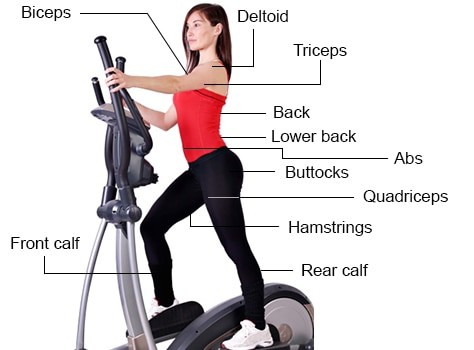
Upper Body muscles worked
Does the elliptical work your arms?
Yes, an elliptical workout does engage your arm muscles. The primary arm muscles involved are the biceps and triceps. When you push the elliptical’s handlebars forward, your triceps are activated, responsible for straightening your arm. On the other hand, when you pull the handlebars toward you, your biceps come into play, bending your arm. Additionally, an elliptical workout also engages the muscles in your upper back, chest, and shoulders, including the trapezius, latissimus dorsi, rhomboids, pectoralis major, anterior deltoid, and serratus anterior, making it a comprehensive full-body exercise.
In addition, the elliptical works your other upper body muscles, including:
Back – Traps, Lats, and Rhomboids
Your back muscles, including the trapezius (traps), latissimus dorsi (lats), and rhomboids, are involved in the elliptical workout. While you push and pull the handlebars, the traps contribute to retracting and depressing your shoulder blades. The lats, responsible for arm movements, aid in the scapula’s motion. The rhomboids, positioned beneath the traps, retract your shoulder blades during the elliptical’s pulling motion.
Chest
The elliptical machine provides a workout for your chest muscles. While pushing the handlebars forward, the primary muscle involved is the pectoralis major. This large muscle located on the front of your upper body plays a role in flexing, adducting, and internally rotating your humerus. While elliptical work won’t replicate a bench press, it can build endurance in your chest muscles.
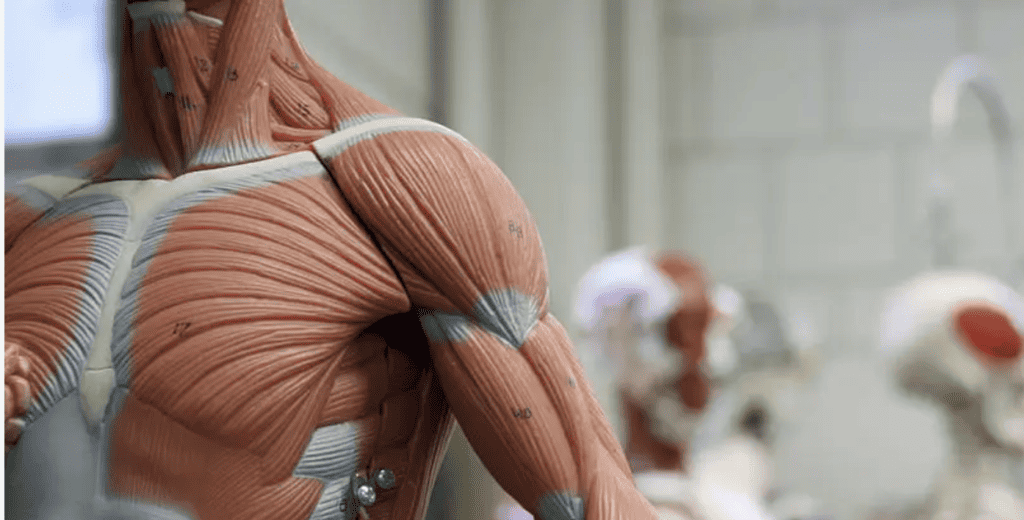
Shoulders
The anterior deltoid muscle, part of the shoulder muscles, gets activated during your elliptical workout. Located at the front of your shoulder, the anterior deltoid aids in shoulder flexion as you push the handlebars forward. Additionally, the serratus anterior, situated on the side of your chest, contributes by protracting your scapula each time you push the handlebars forward. Together, these shoulder muscles play a crucial role in your elliptical exercise routine.
Lower Body muscles worked
1. Does the elliptical work your glutes?
Yes, the elliptical does work your glutes. Hip extension, a key movement in elliptical exercises, especially when using an incline, actively engages the gluteus maximus—the largest of the three gluteal muscles. The higher the incline, the more emphasis on the glutes, similar to walking uphill. Strengthening your glutes with the elliptical can help with exercises targeting your buttocks and overall lower body strength.
2. Does the elliptical work your legs?
Absolutely, the elliptical is an effective workout for your legs. It engages various leg muscles, including the glutes, hamstrings, quadriceps, and calf muscles.
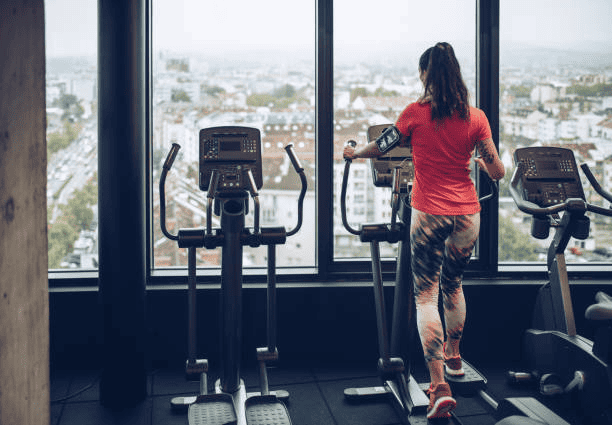
3. Quadriceps – how the elliptical works your quads
The elliptical works your quadriceps as it involves straightening your legs. While you may not feel them working as intensely as on a stationary bike, the elliptical provides a balanced workout for the quads, thanks to other muscle groups sharing the load. Increased resistance or reversed motion can further challenge your quads.
4. Hamstrings – how the elliptical works your hamstrings
The elliptical activates the hamstrings on the back of your legs as they assist with hip extension and knee flexion during the elliptical motion. Utilizing the incline feature intensifies the hamstring engagement, similar to hill climbing, and moving in reverse also emphasizes the hamstrings.
5. Calf Muscles – how the elliptical works your calves
Your calf muscles come into play as you perform plantarflexion by pressing the pedals on the elliptical. For enhanced calf muscle engagement, increase the machine’s incline. Strengthening calf muscles is vital not only for stability but also for preventing injuries associated with daily activities.
Core and Abs
Does the elliptical work your abs/core?
Yes, the elliptical indeed engages your core muscles, provided you maintain proper posture and balance during your workout. If your goal is to work your core, avoid leaning heavily on the handles, as this decreases the involvement of your abdominal muscles.

Which abdominal muscles does the elliptical work?
The elliptical targets various abdominal muscles, including:
Rectus Abdominis:
These are commonly known as the “six-pack” muscles. Running vertically along the front of your torso, the rectus abdominis is responsible for spinal flexion and anti-extension. This muscle helps maintain stability and an upright posture while using the elliptical.
Obliques:
There are two sets of oblique muscles, the internal and external obliques. They run from the hips to the ribcage and are responsible for torso rotation and preventing excessive rotation during elliptical movements.
Transverse Abdominals (TA):
The deepest core muscle, the transverse abdominis acts like a corset, maintaining abdominal tension, protecting and stabilizing your spine. These muscles work isometrically to keep you stable and facilitate the transfer of power between your upper and lower body.
Erector spinae and hip flexors
In addition to these core muscles, the elliptical also engages your erector spinae muscles, which run along your spine and contribute to maintaining an upright posture, and your hip flexors, which flex your hips as your legs move forward and up during the elliptical stroke. All these muscles work together to stabilize your spine and pelvis while you exercise.
But, Does an Elliptical Build Muscle?
Yes, the elliptical can contribute to muscle growth, but it should be part of a comprehensive fitness plan that includes proper resistance training and nutrition. While it’s not as effective as activities that engage fast-twitch muscle fibers (like resistance training) for building muscle, the elliptical’s slow-twitch muscle fiber engagement, primarily aimed at muscular endurance, can play a supporting role in muscle building. Improving your aerobic endurance on the elliptical can enhance your recovery between resistance training sessions and sets of strength training exercises, helping you build muscle and strength over time.
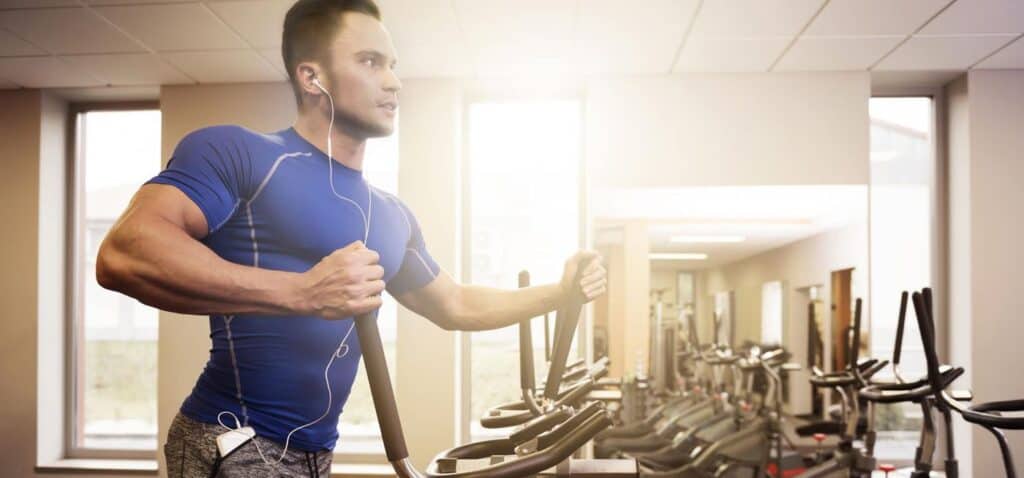
What is the best way to build muscle with an elliptical?
To maximize muscle-building potential on the elliptical:
- Cardio and Strength Training: Use the elliptical in combination with other muscle-building exercises. High-Intensity Interval Training (HIIT) is an effective approach, combining short bursts of maximum effort with rest intervals. Alternatively, make use of the elliptical’s incline feature to increase the challenge for specific muscle groups, such as quads and glutes in the forward motion and hamstrings and calves in the backward motion.
- Recovery Day Training: On recovery days, perform low-intensity steady-state cardio on the elliptical for 30-45 minutes at a pace where you can maintain a conversation. This complements your muscle-building efforts without hindering them.
What else do you recommend to build muscle in addition to using an elliptical?
While the elliptical can play a role in muscle building, it’s essential to combine it with other muscle-building strategies:
- Resistance Training: Engage in regular resistance training exercises that specifically target various muscle groups. Activities like weightlifting, bodyweight exercises, and resistance bands can help you build and strengthen muscles more efficiently.
- Proper Nutrition: Consume a balanced diet rich in protein, healthy fats, and complex carbohydrates. Protein is particularly crucial for muscle growth and repair.
- Adequate Rest and Recovery: Ensure you get enough sleep and allow your muscles to recover between workouts. Muscles need time to repair and grow stronger.
- Hydration: Staying well-hydrated is essential for overall health and muscle function.
- Progressive Overload: Gradually increase the intensity and resistance of your workouts to continually challenge your muscles and promote growth.
By combining these factors with the elliptical and its supporting role in muscle building, you can achieve more comprehensive muscle development and fitness goals.
Ellipticals We RecommendEllipticals We Recommend




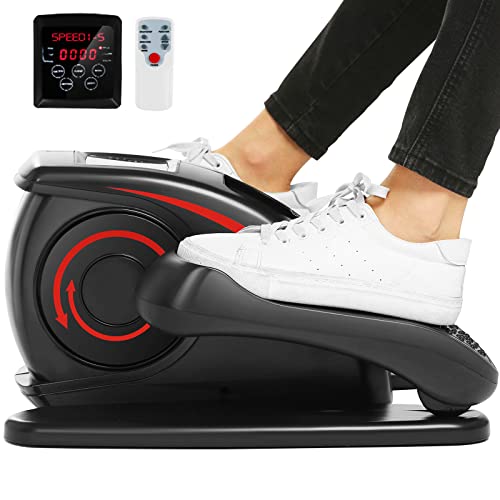





Last update on 2024-07-26 / Affiliate links / Images from Amazon Product Advertising API
Workout Types You Can Do on the Elliptical
Tips for Targeting the Right Muscles on the Elliptical:
When using the elliptical, focus on proper form and resistance to engage the right muscles effectively. To target both upper and lower body muscles, maintain a steady pace with moderate resistance. For a lower body emphasis, use a higher incline with strong resistance. To engage the upper body, utilize the moving handles and add resistance. Vary your workouts to challenge different muscle groups while ensuring recovery days to support muscle growth and endurance.
Workout Types when Using Your Elliptical:
Steady State Workout: Warm up for 5 minutes with low resistance, then increase resistance for 30 seconds and recover for 30 seconds, repeating 5 times. Follow this with 25 push-ups and 25 squats, then increase the incline for 1 minute, repeating 3 times. Finish with 25 push-ups and 25 lunges per leg.
High Intensity (HIIT) Workout: Warm up for 5 minutes, then alternate between 20 seconds of maximum resistance and 40 seconds of lower resistance for 10 minutes. For the next 10 minutes, go as fast as you can on a challenging incline for 20 seconds, followed by 40 seconds of recovery at the same incline. For the final 10 minutes, alternate between 30 seconds of backward motion and 30 seconds forward motion.
You can create a full-body workout routine that combines the elliptical with the additional upper and lower body exercises. Here’s a sample workout plan that incorporates everything into a single session:
Full-Body Elliptical and Strength Workout:Note: Be sure to warm up for 5-10 minutes on the elliptical at a low intensity before starting the strength exercises.
Full-Body Elliptical and Strength Workout: Note: Be sure to warm up for 5-10 minutes on the elliptical at a low intensity before starting the strength exercises.
1. Steady State Elliptical Warm-Up:
- Duration: 5-10 minutesResistance: Low to moderateFocus on getting your heart rate up and preparing your muscles for the strength exercises.
- After the warm-up, move to the upper body exercises.
- Perform 3 sets.Repetitions: 8-10 per set.Rest: 1-2 minutes between sets.
- Perform 3 sets.Repetitions: 10-15 per set.Rest: 1-2 minutes between sets.
- Perform 3 sets.Repetitions: 8-12 per set.Rest: 1-2 minutes between sets.
- Perform 3 sets.Repetitions: 8-10 per set.Rest: 1-2 minutes between sets.
- Hop back on the elliptical for a cardio segment.Duration: 5-10 minutes.Resistance: Moderate to high.This cardio segment serves as an active rest and keeps your heart rate up.
- After the elliptical cardio segment, move to the lower body exercises.
- Perform 3 sets.Repetitions: 8-12 per set.Rest: 1-2 minutes between sets.
- Perform 3 sets.Repetitions: 10-12 per leg per set.Rest: 1-2 minutes between sets.
- Perform 3 sets.Repetitions: 6-8 per set.Rest: 1-2 minutes between sets.
- Finish with 3 sets.Repetitions: 12-15 per set.Rest: 1-2 minutes between sets.
- Return to the elliptical for a cool-down segment.Duration: 5-10 minutes.Resistance: Low.This cool-down helps your heart rate gradually return to normal and promotes recovery.
This full-body workout combines the benefits of cardio and strength training, making it a well-rounded routine that targets multiple muscle groups while utilizing the elliptical as an integral part of your exercise session. Make sure to adjust the weights and resistance levels according to your fitness level and goals.
An ex-triathlete, fitness coach and writer with a Masters in Sports Physiology. Fitness is my passion and I've had my fair share of home fitness equipment tried and tested!



3 Comments